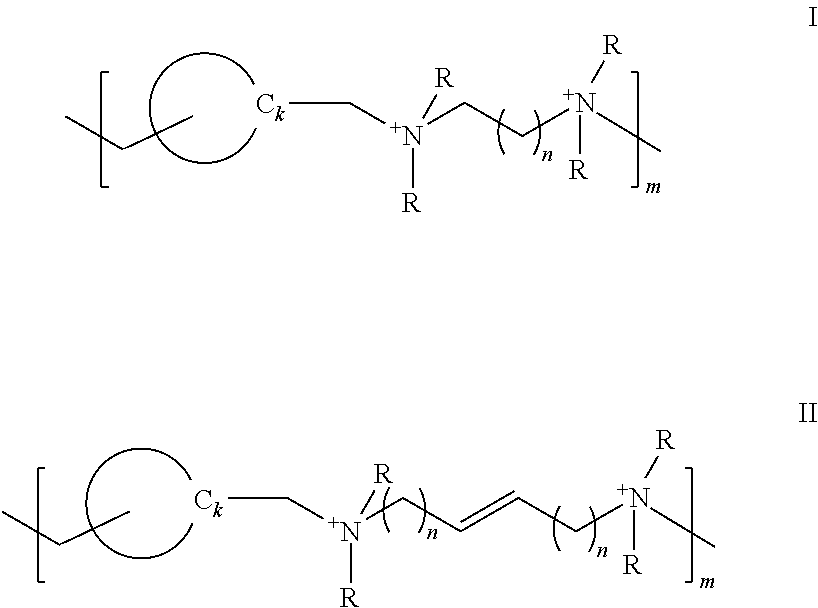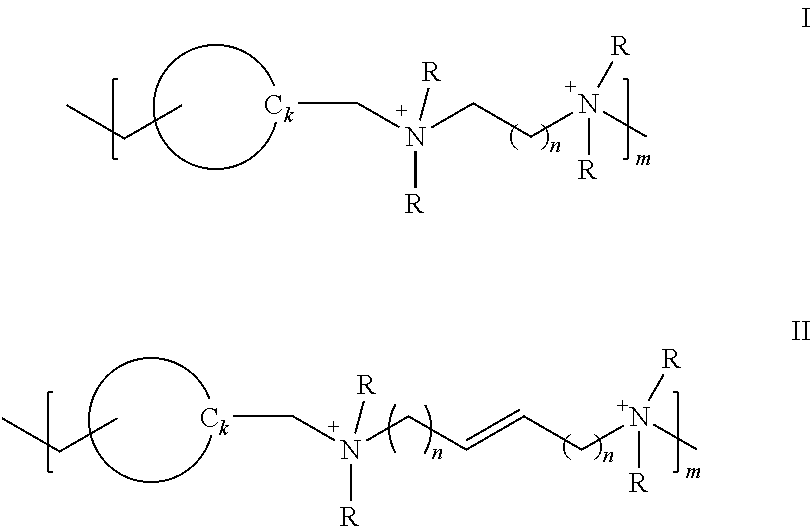Polymeric quaternium compounds
a technology of polymer quaternium and compound, applied in the field of polymer quaternium compounds, can solve the problems of irritating such tissues with preservation agents, and achieve the effect of reducing the number of polymer active ingredients and reducing the number of reactive oxygen species
- Summary
- Abstract
- Description
- Claims
- Application Information
AI Technical Summary
Benefits of technology
Problems solved by technology
Method used
Image
Examples
examples 1 to 5
[0126]The following borate buffered formulations were prepared and are reported in Tables 7 and 8. Each formulation includes 0.6 wt. % boric acid, 0.1 wt. % sodium borate about 0.3 to 0.5 wt. % NaCl along with 5 ppm (Ex. No.A) and 10 ppm (Ex. No.B) of each of the exemplary polymeric quaternium compounds. See, Table 7 for the appropriate n value for each of Example Nos. 1 to 4, which correspond to formula I. Example No. 5 is of formula II. Table 8 lists the 4-hour antimicrobial data for each of the solutions.
[0127]
[0128]
TABLE 7Example Nos. 1 to 4Example1234n value 1235
Biocidal Stand-Alone Stability
[0129]In order to assess the antimicrobial activity of the Example formulations, a “Stand-Alone Procedure for Disinfecting Products” based on the Disinfection Efficacy Testing for Products dated May 1, 1997, prepared by the U.S. Food and Drug Administration, Division of Ophthalmic Devices is used. The stand-alone test challenges the Example formulation with a standard inoculum of a represen...
example 6
[0135]A contact lens care solution was prepared according to the formulation represented in Table 9.
[0136]
TABLE 9Componentamount (wt. %)NaCl0.36propylene glycol0.20Tetronic ® 13040.50boric acid0.64sodium borate0.18Dequest ® 20160.10Example 1 (ppm)3Na2EDTA0.05
[0137]
BLDRabbit Ocular Irritation Screen5 ppm RD-2010 (4 Hour Test)at pH 7.5Weighted Draize ScoreStatusPV Lens0PassDirect Installation0PassBLDBiocidal Efficacy ScreenRD-20104 Hour Log Reductions with Organic SoilpHppmS. aureusP. aeruginosa S. marcescens C. albicansF. solani7.55.0>4.8>4.74.51.31.97.52.5>4.84.7>4.81.31.77.85.0>4.8>4.74.84.32.77.82.54.8>4.74.81.91.67.53.0>4.7>4.74.01.41.47.83.0>4.74.74.63.81.5Lens Compatibility(mm Average Change)1 Cycle7 Cycles30 CyclesBLD01ChangeReverseChangeReverseChangeReversePureVision0.0530.0020.039−0.0150.0170.003Diam0.016 −0.0090.017−0.0050.0100.003Sag0.030 0.0120.015−0.0080.004−0.001BCOasys−0.041−0.0020.004 0.001−0.0210.003Diam0.003−0.008−0.003−0.001−0.0030.007Sag−0.0400.0080.0080.002−0.016...
PUM
 Login to View More
Login to View More Abstract
Description
Claims
Application Information
 Login to View More
Login to View More - R&D
- Intellectual Property
- Life Sciences
- Materials
- Tech Scout
- Unparalleled Data Quality
- Higher Quality Content
- 60% Fewer Hallucinations
Browse by: Latest US Patents, China's latest patents, Technical Efficacy Thesaurus, Application Domain, Technology Topic, Popular Technical Reports.
© 2025 PatSnap. All rights reserved.Legal|Privacy policy|Modern Slavery Act Transparency Statement|Sitemap|About US| Contact US: help@patsnap.com



